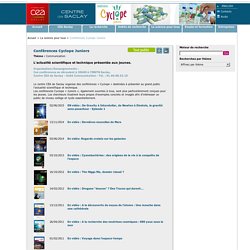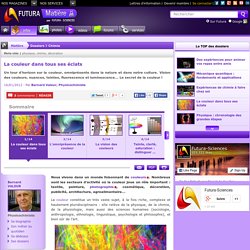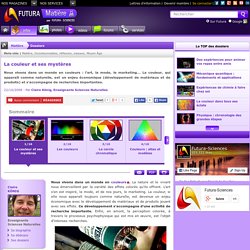

Eirini Nikolintaga
PERDIR. Devoirs faits. Projet coop. Espace Enseignants - Physique-chimie. Conférences Cyclope / La science pour tous. Conférences Cyclope Juniors / La science pour tous. Contacts Accès Accueil CEA Saclay.

La couleur dans tous ses éclats. BernardValeur Physicochimiste Nous vivons dans un monde foisonnant de couleurs.

Nombreux sont les secteurs d’activité où la couleur joue un rôle important : textile, peinture, photographie, cosmétique, décoration, publicité, architecture, agroalimentaire... La couleur constitue un très vaste sujet, à la fois riche, complexe et hautement pluridisciplinaire : elle relève de la physique, de la chimie, de la physiologie, mais aussi des sciences humaines (sociologie, anthropologie, ethnologie, linguistique, psychologie et philosophie), et bien sûr de l’art. La couleur peut être fluorescente. © B. La couleur et ses mystères. ClaireKönig Enseignante Sciences Naturelles Nous vivons dans un monde en couleurs.

La nature et le vivant nous émerveillent par la variété des effets colorés qu'ils offrent. L'art s'en est inspiré, la mode, et de nos jours, le marketing. La couleur, si elle nous apparaît toujours comme naturelle, est devenue un enjeu économique avec le développement de matériaux et de produits jouant avec ses effets. Empereurs byzantins "nés dans la pourpre", rouge écarlate du manteau du Christ, fabuleux "pays de cocagne" où l'or bleu du pastel en coques assure indéfiniment la prospérité générale...
Irisation d’opale Une exposition internationale a eu lieu au Musée des beaux-arts de Carcassonne (1999-2000) puis au Centre de documentació i Museu tèxtil de Terrassa, près de Barcelone (2000) sur le thème de l'importance culturelle et économique de colorants extraits du monde vivant. SOLO Hexagon Generator. This HookED app populates a SOLO Hexagon Template.

Brainstorm content ideas and enter them in the fields below. Click “Generate Document” to populate the template. Print the template and cut out the hexagons. Ask students to arrange the hexagons in sequences and clusters, justifying and annotating any connections made. Unistructural learning outcome-student identifies one hexagonMultistructural learning outcome-student identifies several hexagonsRelational learning outcome-student connects hexagons and explains the connections with annotations.Extended abstract learning outcome– student tessellates (clusters) hexagons adding annotations to make generalisations about a vertex (intersection point). Learning and leading. In New South Wales, Australia, the 2014 school year is just about to start so I thought I’d share with you my 4 professional goals for 2014.

Goal #1 – Keeping science real 2013 was the year where I started the journey of connecting my students with current, practising Australian scientists. This was a response to our students’ survey responses that they did not know many careers or jobs that science can lead them to. They also did not know what scientists actually do. Many students have accountants, tradespeople, bankers, etc within their families or family friends but students often do not have exposure to scientists in their everyday lives (ask a student to name a scientist and they’ll still tell you Isaac Newton or Albert Einstein; they rarely name a living scientist). 2014 will also be the year where I want to utilise social media and technology to connect students with scientists, not just in Australia but from around the world.
Goal #2 – Embed science communication into my teaching. Mix. LASER Classroom™ IYL 2015 - LASER Classroom™ Magic-of-light.org. Resources and tools for Optics and Photonics Educators. SPIE has assembled this list of websites containing lesson plans, activities, demonstrations and free materials to provide resources for educators, parents and students.

Use them to bring light into your classroom! The Exploratorium Science Snacks - Snacks about LightNASA Educational Materials - Light and Color activities for grades K-12Flame Challenge--What is Color? - Winners from the 2014 Flame Challenge explain colorCanon Science Lab - What is Light? 2015 International Year of Light - Official website listing events, resources, sponsors and information on how to get involved International Year of Light Posters - Dozens of free posters available for downloadNanoscale Informal Science Education - International Year of Light Resources assembled by NISE Discover Engineering – Information about Engineers Week, self-guided tutorials content and activities for volunteers and educators TeachEngineering.com - Browse standards based K-12 curriculum modulesWhat Is Engineering? S'COOL Lesson Plans. Explore Sound - welcome to exploring. The Science of Vision and the Emergence of Art. Andy Warhol's Marilyn Prints. In the 1960s, Andy Warhol created several “mass-produced” images from photographs of celebrities such as Marilyn Monroe, Elvis Presley and Jackie Onassis.

Andy Warhol (1928-1987) was a key figure in Pop Art, an art movement that emerged in America and elsewhere in the 1950s to become prominent over the next two decades. The Fauves used non-representational color and representational form to convey different sensations. Apply the same idea to the portrait of Marilyn Monroe below, using the controls to adjust the colors. How does the color affect the mood? Unlike the Fauve colors, the non-representational colors of Pop Art do not depict the artist’s inner sensation of the world. Warhol discusses his choice of color in this 1981 recording. On the occasion of Marilyn Monroe’s suicide in August 1962, Warhol used this image for his screenprinting.
Warhol was fascinated with morbid concepts. In August 62 I started doing silkscreens.